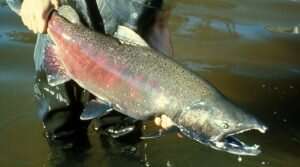NOVEMBER 15, 2019
by Zoe Gentes, Ecological Society of America
 Chinook salmon are also known as king salmon. They depend on healthy estuaries to spawn, which also provide habitat for invertebrates and smaller fish. Credit: U.S. Fish and Wildlife Service.
Chinook salmon are also known as king salmon. They depend on healthy estuaries to spawn, which also provide habitat for invertebrates and smaller fish. Credit: U.S. Fish and Wildlife Service.
Fish permeate the culture of the Pacific Northwest (PNW). In particular, the iconic salmon has been an important part of the region for thousands of years, from ancient Native American trade routes and legends to modern fishing and sporting. In the area of the Salish Sea—inland waterways including Puget Sound, the Strait of Georgia, and the Strait of Juan de Fuca—the cultures, economies, and technologies there are all impacted and influenced by salmon. It is no wonder, then, that salmon are of high conservation interest and constitute a large proportion of hatchery-raised fish in the region.
A recent study in the Ecological Society of America's journal Ecosphere examines hatchery practices in regard to how the Chinook salmon that are released back into the natural waterways in the PNW are affecting wild populations.
In the face of changing climate, ocean conditions, freshwater habitat loss, and increased human consumption, many salmon populations in the PNW are depleted relative to historical abundance. A large salmon, for instance, is a prized and sought-after catch for a sport fisher. There is a growing demand for salmon hatcheries to provide food security and to bolster fish populations; many hatcheries release fish after they reach a certain age or size, with a goal of increasing opportunities for commercial, recreational, and indigenous fishers.











No comments:
Post a Comment
You only need to enter your comment once! Comments will appear once they have been moderated. This is so as to stop the would-be comedian who has been spamming the comments here with inane and often offensive remarks. You know who you are!